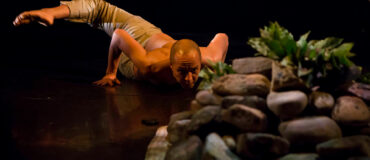To talk about dance in the 21st century, one must reach far beyond the genres of Western concert dance. Ballet, modern, jazz and contemporary dance are merely starting points for current discourse. Ask Peter DiMuro, director of Dance/MetroDC, a regional dance service organization serving metropolitan Washington, D.C., under the auspices of Dance/USA. DiMuro noted that 70 percent of Dance/MetroDC’s constituents are not ballet, modern, or jazz-based artists. In surveys and listings they get lumped together under the label “other.” “Even though it’s the majority, we’re still calling it ‘the other,’” DiMuro said.
University dance departments are struggling with these classifications as well. At a dance department in the spring semester of 2010 (the school will remain nameless to protect the not-so-innocent!), a student was told that a given work was not acceptable because it looked like it could have come out of the theater department. The same semester at another school, a student who organized a performance of percussive dance within a strong modern department was discouraged by faculty who felt the content was too entertaining to be artistically serious. What do these stakeholders feel they are protecting or preserving? When can we borrow from some traditions but steer clear of others? How do the younger generations differ from the older on issues of fusion and cross-pollination?
These potentially contentious and often personal questions were raised in an engaging panel and group discussion entitled, “To Fuse or Not: Fusion and World Dance,” facilitated by DiMuro at the Dance/USA 2010 Annual Conference: Dance Beyond Borders. One panelist, Ana Maria Alvarez, founded Contra-Tiempo, an activist contemporary Latin dance company, in Los Angeles in 2005. Alvarez spoke about how her struggles in graduate school proved generative for her work: “No matter what dance pieces I did, people still read my race and cultural background. It was a lot of tears and hollering and arguing, and of fighting back or pushing back, but I definitely began to see the power of engaging who I was. I created Contra-Tiempo and used salsa as a metaphor for pushing back.”
Panelist Jessica Robinson Love, of CounterPulse, a multifaceted presenting space in San Francisco, spoke about the organization’s commitment to artists involved in trailblazing and genre-smashing projects, like queering classical Cambodian dance. She highlighted the shifting ground in the dance world that requires a new paradigm, one that is not constrained by traditional genre classification. Emiko Tokunaga, faculty member at the Boston Conservatory and co-founder of New York-based Tokunaga Dance Ko., reminded participants that even the traditional genres are not as fixed as we sometimes imagine. “Dance is a mutt!” Tokunaga exclaimed. “What we consider traditional dance forms are amalgams of many dance forms. The field is full of mutts.”
The panel was an exciting reminder that all kinds of borders are currently being questioned and expanded. Artists like Nancy Bannon of New York and Tino Sehgal of Berlin are creating work that can’t accurately be classified as strictly dance or visual art. Sexual identity politics have radically changed in the past few decades; as DiMuro half-joked, “all the kids are metrosexual now!” Hip hop and tap and folklorico and modern are being combined in all sorts of new formations every day. All of these simultaneous contestations are influencing and feeding into each other. What will we call these new mutts? Do we need new labels? Who does the labeling – the artists, the presenters, the public? Will there be spaces for these new forms to evolve? And, more importantly, does the dance field have the will to teach and curate and create in ways that nurture these exciting hybrids.
Ellen Chenoweth is the projects manager at the Liz Lerman Dance Exchange in Takoma Park, Md. She maintains a blog at Widening the I (wideningthei.wordpress.com) and received her M.A. in Dance from Texas Woman’s University in 2009.
____
We accept submissions on topics relevant to the field: advocacy, artistic issues, arts policy, community building, development, employment, engagement, touring, and other topics that deal with the business of dance. We cannot publish criticism, single-company season announcements, and single-company or single artist profiles. Additionally, we welcome feedback on articles. If you have a topic that you would like to see addressed or feedback, please contact communications@danceusa.org.
Disclaimer: Opinions expressed in guest posts do not necessarily represent the viewpoints of Dance/USA.



